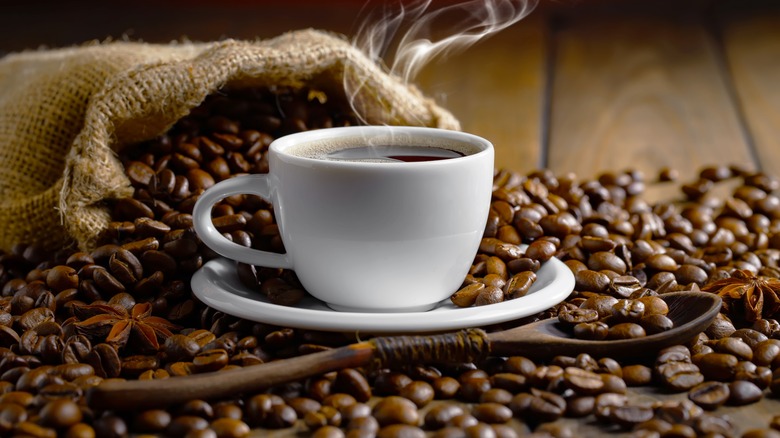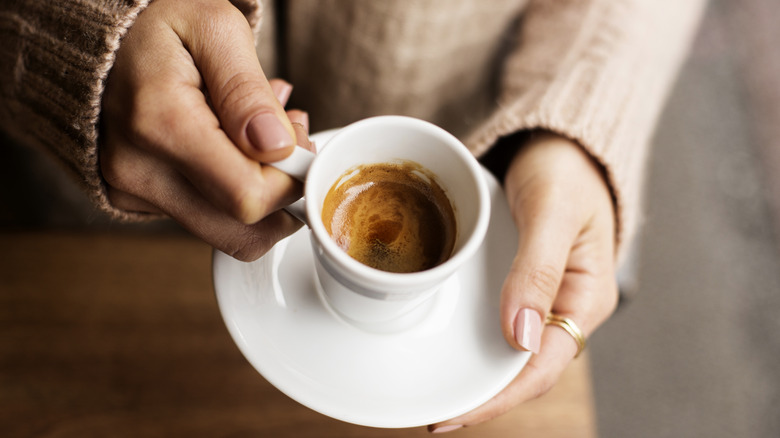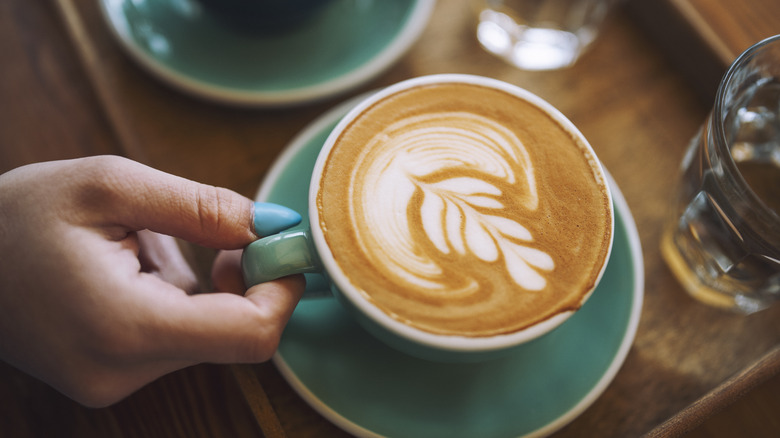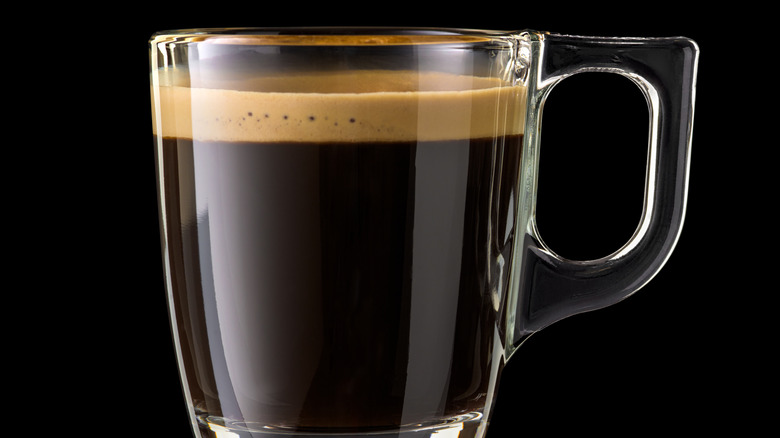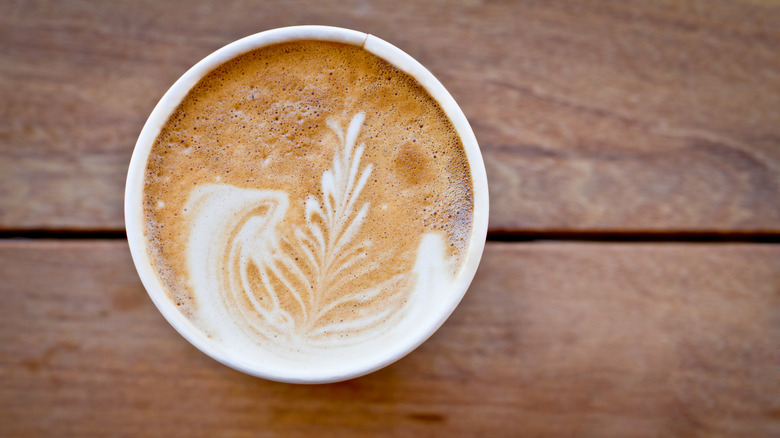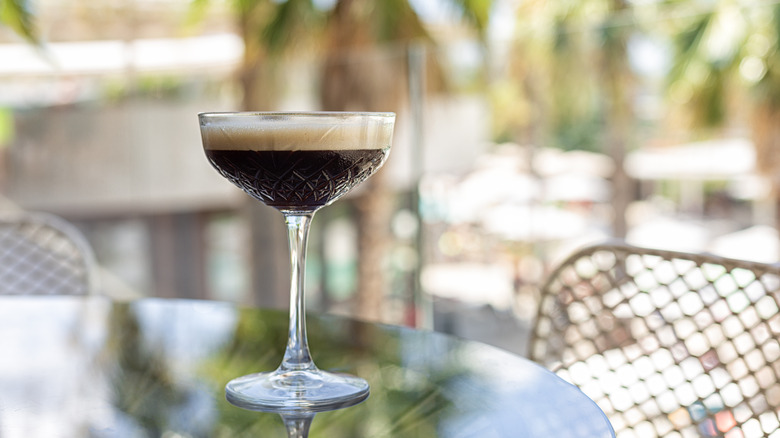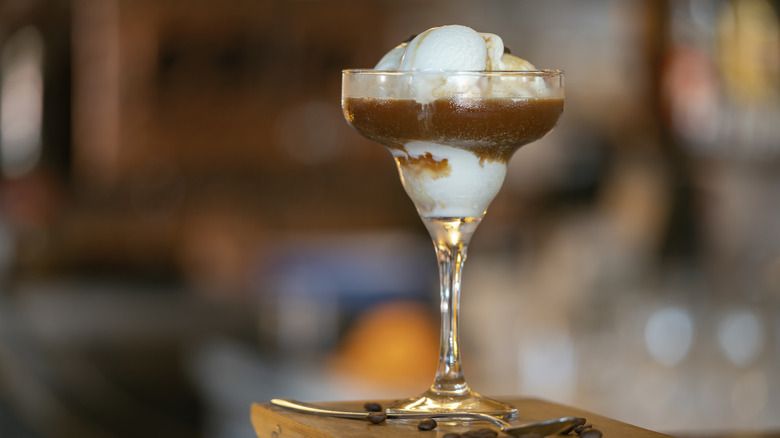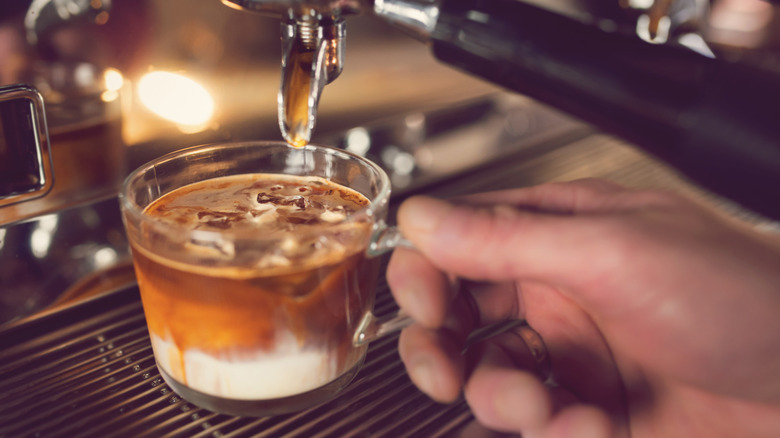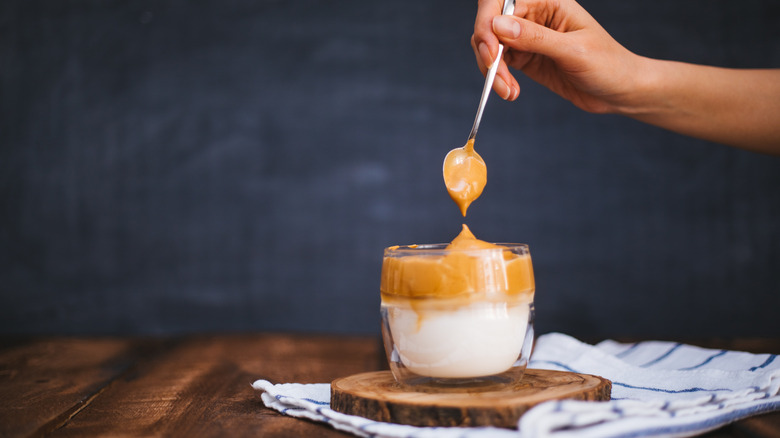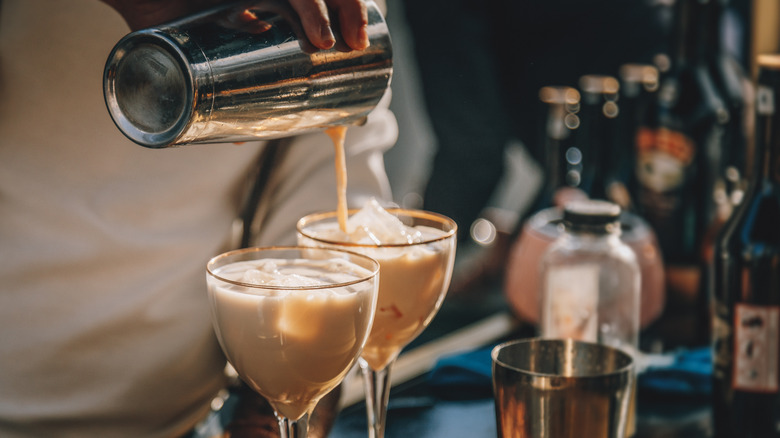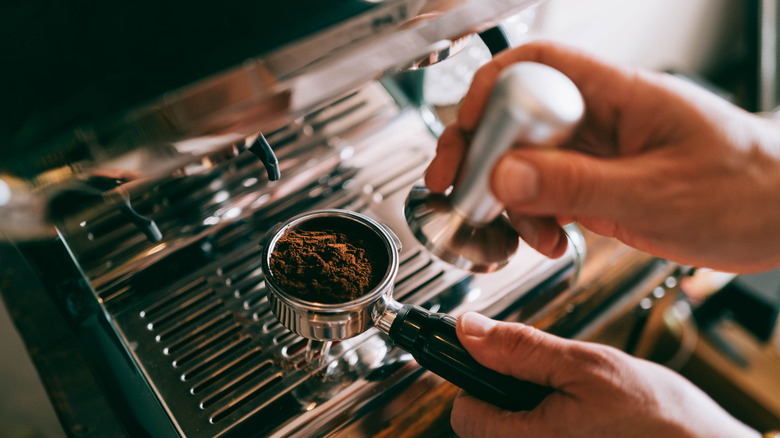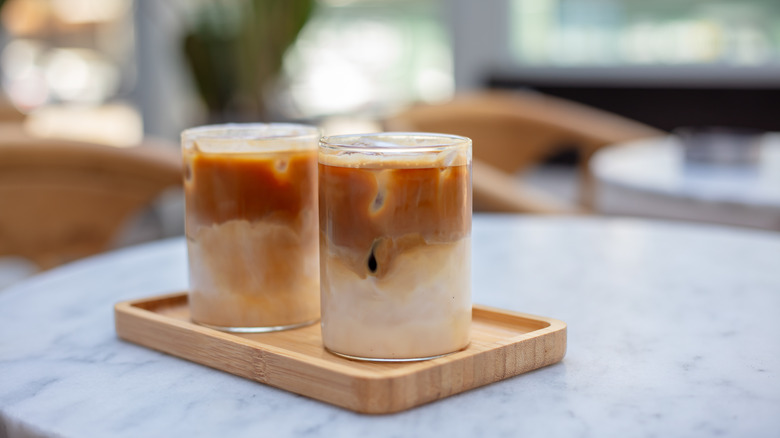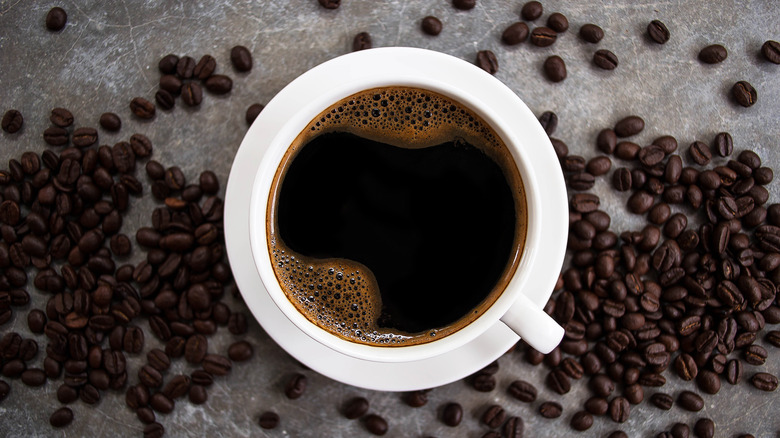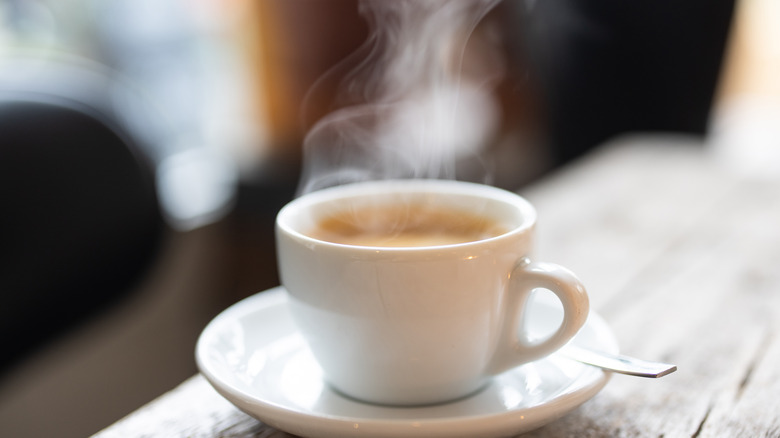13 Types Of Italian Coffee You Need To Try At Least Once
Italian culture is synonymous with many things, like simple and delicious cuisine using the finest ingredients from every region in the country. But did you know that within that culinary history there is an expansive coffee tradition that dates back hundreds of years? In fact, many of the coffee varieties you find at your local cafe have origins in Italian-derived specialties that are easy, delicious, and pack a serious caffeine kick.
Coffee first appeared in Italy in the 16th century, with Venice being one of the first areas in Europe to import coffee beans and brew the beverage. In fact, Caffè Florian, located in Venice, which dates back to 1720, is the oldest coffee house in the world still in operation. By the 19th century, Italy emerged as a premiere leader of coffee commerce, thanks to the invention of the espresso machine by businessman Angelo Moriondo. With this rich history of coffee adoration comes a host of cultural etiquette surrounding coffee and how it's meant to be enjoyed. And while you may be familiar with espresso and cappuccino, there are a host of other coffee varieties from Italy that are worth your time. Here are 13 of the most popular coffees and how you can easily master them at home if your Starbucks begins to get stale.
1. Espresso
The foundational ingredient in a majority of Italian coffee varieties is the humble, yet highly caffeinated espresso. Espresso is different from coffee, and is ubiquitous in Italian culture, finding its way into cocktails, desserts, and more. But if you go to Italy and ask for an espresso, you might be ousted quickly as a tourist. That's because espresso in Italy is simply known as "caffè" because it's the most common type of coffee ordered. Espresso came onto the scene in Italy in 1884, allowing users to "express" hot water through coffee beans, creating a short, concentrated drink that could be consumed on-the-go — hence, where espresso got its name. Once the machine was perfected in 1901, espresso became a popular drink across Italy, delivering a quick and powerful dose of caffeine.
With many years of practice, espresso has been perfected and can easily be made at home. A good rule of thumb is to use 1 ½ tbsp of coffee per 5 ½ fl oz water for a proper, traditional espresso. The result will be about an ounce worth of coffee that can be enjoyed with a bit of sugar to sweeten the bitter taste.
2. Cappuccino
If you're the type who enjoys a bit of milk with their coffee, look no further than the beloved Italian cappuccino. The frothy breakfast drink is much admired around the world for its more balanced flavor profile accompanied by soft, foamed milk different from the latte we enjoy today. Its history is also just as rich as that of espresso.
You may be surprised to learn that the Italian cappuccino was influenced by a drink that first appeared in the coffeehouses of Vienna in the 18th century. But once the espresso was introduced and popularized in the early 1900s, the cappuccino followed shortly thereafter. The name's origin, however, is a bit more unique than espresso's. "Cappuccino" is actually derived from an order of friars known as the Capuchin, who wore rich brown hoods with white details that resembled the drink. After World War II, cappuccinos became known as the go-to breakfast drink by Italians. Often enjoyed with a simple pastry, Italians prefer cappuccino for breakfast because they do not believe that milk should be enjoyed after 12 p.m. — because it's considered a cultural faux-pas in Italy to order cappuccino in the afternoon.
Today, you can easily make a cappuccino at home. Brew espresso in your preferred method, then add equal parts steamed milk and frothed milk to your cup. Top with cinnamon, cocoa powder, or whatever else you enjoy, and buon appetito.
3. Caffè Lungo
If a highly concentrated, single sip of espresso is not your thing, why not try a lungo? Caffè lungo, which means "long shot," is like an espresso but bigger. Instead of making a typical espresso in a 1:2 ratio of coffee beans to hot water, you would instead use a 1:3 or 1:4 ratio so the drink is slightly larger in volume. This is the opposite of the popular caffè ristretto, which uses less water than it does coffee beans to create an even more concentrated espresso that can be downed quickly.
There's something to consider before trying a lungo — because the ratio of coffee beans is the same as espresso, you won't get more caffeine in a lungo than you would in an espresso. Instead, you will get a more developed flavor profile with the greater dilution of the coffee beans, magnifying the inherent notes of the roast.
4. Caffè Latte
While you're likely familiar with the latte thanks to its popularity in cafes across the U.S., caffè latte in Italy is not the same as what we get here. Caffè latte means "coffee with milk" and is as simple as saying you'd like milk with your coffee. The way that milk comes can also vary — either steamed, frothed, or a combination of both, depending on the barista and the cafe. If you order "caffè con latte" you might get just a splash of milk added to your coffee.
The key difference between the popular latte we know in the U.S. and the caffè latte popularized in Italy is the ratio of milk to espresso. Caffè latte has a 2:1 ratio of milk to coffee, with the steamed milk instead of frothed milk, which results in a creamier, less concentrated flavor. Lattes, on the other hand, have a 1:2 ratio of coffee to milk, with the milk being both steamed and frothed for a fluffier consistency. You'll find that American lattes are more coffee-forward flavorwise than their Italian counterpart. To recreate the caffè latte at home, simply follow the customary proportions, or add a bit of frothed milk for an American twist.
5. Shakerato
Not all coffees need to be served hot, and iced coffee varieties are just as popular in Italy as they are in the U.S. A streamlined and elegant take on the iced coffee that you can often find served in a cocktail glass is the shakerato. If this is your first time hearing about it, prepare to meet your newest coffee obsession.
The word shakerato means "shake," although its true origins remain unknown. Many regions in Italy wish to claim the shakerato as their own invention, but that history is highly contested. There is evidence, however, that iced coffee generally appeared in Italy around the late 1700s. Presumably, the shakerato followed soon after. Regardless of where it came from, the shakerato is a wonderful summer treat that won't get watered down like traditional iced coffee.
Like many Italian drinks, a shakerato is simple to execute and delicious in its overall flavor impact. To make one at home, just add a shot of espresso, ice, and a bit of sugar to taste to a cocktail shaker and shake it up until it gets a bit frothy. Pour it into a cup, or better yet, a martini glass, and enjoy it on a hot summer afternoon.
6. Affogato
Affogato is more of a dessert than a pick-me-up beverage, and if the mood strikes you, consider it as one of many excellent additions to your coffee. Affogato literally translates as "to drown," which is exactly what the drink is — a flavor of gelato, typically vanilla, is drowned with a shot of espresso for a sweet-and-bitter, hot-and-cold beverage-dessert kick that can be eaten with a spoon.
Much like the shakerato, the origin of the affogato is questionable. Some claim it originated in the 17th century with Franciscan friar Angelico (who also created the popular Italian liqueur Frangelico) while others believe that the affogato wasn't popularized until the 1950s when ice cream became the modern, widely available treat we know it as today.
Regardless of how or when it was invented, thank goodness it was! If you're looking for a bit of decadence with your morning coffee, the affogato is easy enough to create at home. Choose your favorite flavor of gelato, brew your espresso, and pour the brew over a few scoops of ice cream. That's all it takes!
7. Macchiato
Italians have a lot of names for coffees with milk in them, but perhaps the most misunderstood is the macchiato. When you order a macchiato in Italy, you'll receive a shot of espresso with a splash of steamed or foamed milk. Unlike the caffè latte, the macchiato is distinguished by its very small amount of milk. Typically, macchiatos are suitable for those who just want a touch of milk in their coffee to add a bit of creaminess, but still want the quick drinkability of an espresso.
The word macchiato translates to "marked" or "stained," and was originally used by waiters to determine which espresso orders had a bit of milk in them and which didn't. It's hard to say where and when the macchiato comes from, but if you find espresso to be a bit too bitter, it's worth giving this drink a try. Making a macchiato at home is easy enough; just add a splash of warm or steamed milk to your espresso and enjoy.
8. Crema di Caffè
Like affogato, crema di Caffè can be a dessert-style coffee, depending on who you ask. "Crema di Caffè" is Italian for coffee with cream, but there's a better way to add sugar and cream to your coffee. Italians took this decadent beverage a step further by combining the coffee with cream into a mousse-like consistency that makes for a delicious after-dinner treat you're sure to love.
To make crema di Caffè, brew a shot of espresso as you normally would — we recommend the Moka pot — and allow your espresso to cool down since this drink is usually served cold. Combine a quarter cup of espresso with a cup of heavy cream and powdered sugar, then whip the heavy cream until soft peaks begin to form, then spoon it into a cup and enjoy it as is.
For another popular iteration of crema di Caffè, we recommend trying a granita-style coffee. For a granita, you'll need the exact same ingredients to create the cold, refreshing beverage. But instead of allowing your espresso to cool down, though, you freeze it and chip it off into a glass once it's frozen. Then add your whipped cream to the top for some added creamy sweetness.
9. Caffè Corretto
Coffee isn't just a morning drink. With a little bit of adjustment, the Italians have created a perfect coffee beverage to enjoy after 5 p.m. What we know today as "caffè corretto" refers to any coffee with a bit of alcohol in it. The type of alcohol is up to you, though the most commonly enjoyed in Italy are typically grappa, brandy, or aquavit. Southern Italians also love a bit of Sambuca with their brew.
So where did caffè corretto come from? According to historian Dr. Diana Garvin (via Punch magazine), Italians were likely enjoying coffee with alcohol as far back as the 17th century when coffee first appeared in Italy, but the term "caffè corretto" likely didn't come along until the 1930s under Mussolini's fascist regime. Garvin posits that because high tariffs were imposed on coffee during the time, Italians were forced to resort to other coffee bean substitutes such as chicory or orzo. Because it wasn't nearly as flavorful, people began adding alcohol to "correct" the taste. Now, caffè corretto is a staple at most Italian cafes and enjoyed all over the country. The drink is easy enough to replicate at home — just add a shot of your favorite liquor to a shot of espresso, and you'll have a perfect cup of "corrected" coffee.
10. Caffè d'orzo
Speaking of coffee bean alternatives, one of the few that have endured up until today is orzo, or barley. That means if you order caffè d'orzo off a menu, it might come to the table looking like a shot of espresso, but in reality it's not.
For centuries, barley has been part of the Italian diet, but likely up until the 1930s, it was mostly consumed in soups or bread. However, limitations presented during World War II forced the Italians to get creative, and thus, they began using barley as a coffee substitute.
The drink itself is still popular in certain cafes, made with barley grains that's been roasted and ground, similar to coffee beans, and expressed through hot water. The result is a cup that feels and looks similar to espresso, but doesn't actually taste like it. It's a slightly bitter, more earthy and less complex counterpart to espresso. Since it doesn't have any of the caffeine that traditional espresso possesses, it would make a great alternative for those who enjoy a decaf brew.
To make caffe' d'orzo, replace your traditional espresso with ground barley. (If you have trouble finding it at your local store, look for it an international grocery store.) From there, prepare it as you would a normal espresso, and enjoy with or without sugar.
11. Caffè Freddo
Despite a debate about which type of coffee is stronger — cold brew or iced — there's no doubt that a freshing, chilled alternative to try is the caffè freddo. Unlike cold brew, which is made slowly over time by infusing coffee with cold water, caffè freddo takes the sacred Italian espresso and cools it quickly to create a cold drink.
The term 'caffè freddo' means "cold coffee." A caffè freddo is simply an espresso that's been cooled down to room temperature, refrigerated, sometimes for hours, then served with or without ice. If you prefer your espresso with milk, you can try a cappuccino freddo, which typically combines cooled down espresso with cold milk or cold foam to replicate the cappuccino's natural frothiness. For a bit more of an elevated cold coffee version, there's always the shakerato, which cools espresso more quickly within the ice shaker, allowing more of the original flavors of the espresso to shine through.
12. Caffè Americano
World War II was a time of coffee experimentation and reinvention for the Italians, both to satisfy their new palettes and to combat the hefty price tag of coffee beans. Meanwhile, American soldiers stationed in Italy were big coffee drinkers, but reportedly thrown off by the bitter, concentrated taste of espresso. To make the coffee that reminds them of home, they added hot water to the espresso for something more akin to drip coffee. Italians soon picked up on the trend and began calling it caffè Americano.
So does caffè Americano actually taste like drip coffee? It depends on who you ask. Espresso and drip coffee are made from similar types of beans, but adding hot water to espresso to dilute the flavor doesn't necessarily result in the same flavor profile as dripping hot water through ground coffee beans. To make caffè Americano, it's customary to add up to six ounces of hot water to one or two shots of espresso, depending on your taste.
13. Caffè al ginseng
A newcomer to the Italian coffee scene that's gaining a lot of traction is the caffè al ginseng. It first became popular in Milan, Italy, in the mid-2000s, when arabica coffee beans flavored with ginseng arrived from southeast Asia. Since then, you'll find this trendy new brew in cafes all over Italy, though the Milanese are known for popularizing the drink. Unfortunately, not many places in the U.S. have picked up on its popularity yet, but it's something to consider trying if you want to explore more modern Italian fare.
The drink itself is twice the size of an espresso, served with warm milk. The result is a creamy and very sweet drink, not like an espresso at all. But there's still coffee in it, and some say that the ginseng in the coffee could potentially help with digestion.
To make caffè al ginseng at home, take about half a teaspoon of dried ginseng root extract and add it to warm (but not boiling) milk. Like you would with cappuccino, add that warmed milk to your coffee, preferably a ristretto amount of espresso, and add sugar to taste. Then enjoy the heady brew.
